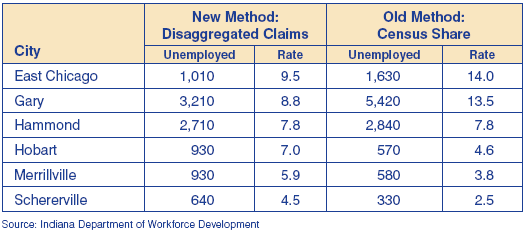A New Approach to City-Level Unemployment Estimates
Beginning with the revised labor force estimates released in August, a change will be introduced in the computation of unemployment estimates for cities with over 25,000 residents. Previously, unemployment estimates for cities were based in large part on a city’s share of the county’s unemployment, as enumerated during the decennial census. Monthly unemployment estimates were computed at the county level, and the pro-rata share based on the census data was then applied to that unemployment estimate to arrive at a city-level estimate, like so:
County unemployment estimate * census share for city =
unemployment estimate for city
However, there are problems with this approach. If a city’s share of the unemployment was disproportionately high during the census for some reason (a recent closing of a significant employer, for example) the city will be “stuck” with that share of the county’s total unemployment until the next census, regardless of how the actual distribution of unemployment between the city and the balance of the county might change during that decade. An additional issue involves the time lag between the actual census and the introduction of census-share ratios for the cities into the modeling software, which might take three to five years.
To respond to this shortcoming, the Bureau of Labor Statistics (BLS), which funds and oversees the production of Local Area Unemployment Statistics estimates, developed an alternate methodology, and Indiana is adopting it with these revised estimates. A residency assignment system maintained by BLS geocodes Unemployment Insurance (UI) claims records based on the claimant address (i.e. assigns longitude and latitude) and assigns place codes based on that “rooftop” mapping of the address. If the address falls within a designated city based on that geocoding, the city’s place code is appended to the record; if the address falls outside the city’s defined limits, no city code is added—although both sets of records will be included in the county’s UI claims for the period. In considering the city’s unemployment claims for the period in question, only the records coded for the city will be included. For example, county claims for Floyd County would include all claims records coded for that county, but claims for New Albany would have an additional place code, allowing us to identify those records and arrive at a separate claims count for New Albany. In the case of a county with multiple large cities for which estimates are produced (e.g., Lake County), each city’s claims are coded separately.
This new approach has the obvious advantage of reflecting month-to-month changes to the distribution of unemployment claims activity between the city (or cities) and the balance of the county. In the case of Lake County, the distribution of unemployment has shifted somewhat since the 2000 census. The new approach captures the fact that Gary and East Chicago now have a smaller proportion of the county’s total unemployment than they did in 2000, while unemployment in some other cities within the county has increased (see Table 1).
Table 1: Lake County City Estimates Comparison, January 2005

It should be noted that the claims counts for cities and counties, while a significant factor, constitute only one of several model inputs used in arriving at unemployment estimates. Some cities will see shifts in their unemployment rates with the 2005 estimates compared to the 2000–2004 benchmarked estimates, which employed the old methodology, and may experience more month-to-month volatility in their unemployment estimates. For example, some cities may see higher unemployment estimates in January than the county as a whole, since retail establishments tend to be concentrated in urban areas, and post-holiday layoffs may be more frequent among city residents based on proximity to those workplaces. In general, the new methodology will provide more accurate, current estimates for cities’ labor force components utilizing current UI claims activity, rather than a static snapshot of unemployment ratios from half a decade ago.
By Vicki Seegert, Manager
Advanced Economic and Market Analysis Group, Indiana Department of Workforce
Development
